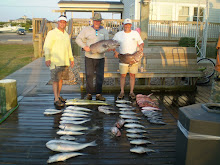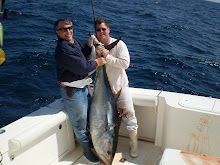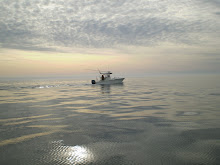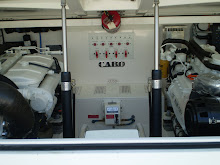 By Jon Kitchen (far right in photo)
By Jon Kitchen (far right in photo)What is your favorite bluefin trolling spread? Mates and captains alike will have very passionate answers to this open-ended question. Some answers will be based upon fishing success, while other answers will be based upon gut feelings. Some spreads are handed down through the generations, while some are simply beginners luck. Some fisherman start and end the day with the same seven baits, while others change one bait with each cycle of Bob Marley’s Jamming.
Logistics
Width: FINOLOGY, my 23-foot Regulator, has 14 tackle trolling positions over a 34-foot span.
Depth: I carry 1# to 3# trolling weights and planers (Old Salty #3 to #24), which will theoretically cover the water column from the surface, down to 225 feet.
Length: I run three Avet 50s, three Avet 30s, and two Penn 9/0 that run anywhere from the back of the boat out to about 120 yards (this is typically my limit even for my Way, Way, Back (WWB)).
Calculating the range of possibilities, from the above statistics, will keep thinking captain awake the night before an offshore trip. After that sleepless night, I typically run seven to eight rods and one to two teasers from the 14 positions on my boat. The WWB goes out first. It is generally a medium chartreuse bird with a small pink islander about 80 yards from the boat. This rod serves two purposes; the bird tells my crew if the boat is straight, and it satisfies my lucky lure spot (a 90.2# bluefin was taken on this rig from my wife's boat - CRISIS II).
Next, my outside riggers are set with large blue/white Ilanders in front of ballyhoo. I found while fighting my big bluefin, these baits can even work when dangling on the water from the outrigger. One of my favorite Ilanders left town when I finally reached the lever drag, gaff in hand for the first fish, and I push too far in my excitement.
The inside riggers are set with single green machines. I have recently gone to heavy weights inside the green machines with more success than the non-weighted ones. One corner will be set with a green or green machine spreader bar. I have actually had more luck with my hand-made green plastic bars than the expensive green machine bars.
The remaining corner will have a planer, set with a skirted ballyhoo. I am not sure really how deep my planers run, but having one bait deeper than all others appears to draw some strikes. I attach my planer to the boat with 400# mono. The rod line is then attached to the planer line with a rubber band and snap. Be careful not to allow the snap to slide all the way to the planer, or the rubber band will break. You can tell that you are too deep when the rod tip jumps rapidly.
Last but not least, I set the teasers. Of course, I hope that the above baits are covered-up before I can deploy all of these rigs. I generally launch a white buoy teaser named Swimmy. With a 2# weight on his nose and flashaboo ribbon for a tail, he swims violently on the end of a bright yellow 20-foot nylon rope. During 2008, most of my bites came right behind this odd-looking predator. I will finish the spread off with a natural cedar plug on a flat line clip about 10 feet behind the teaser.
Throughout the day, I will change things up to target different fish, as required. Some of my alternate lure choices are listed below.
Most successful trolling lures on my boat by species:
Bluefish– Hoochies (white, yellow, orange, red, and purple)
False Albacore – Cedar Plugs (natural)
Skipjack – Zooker Feathers (blue and white)
Yellowfin – Plastic Hawaiian Spreader Bar
White Marlin – Naked Ballyhoo









No comments:
Post a Comment